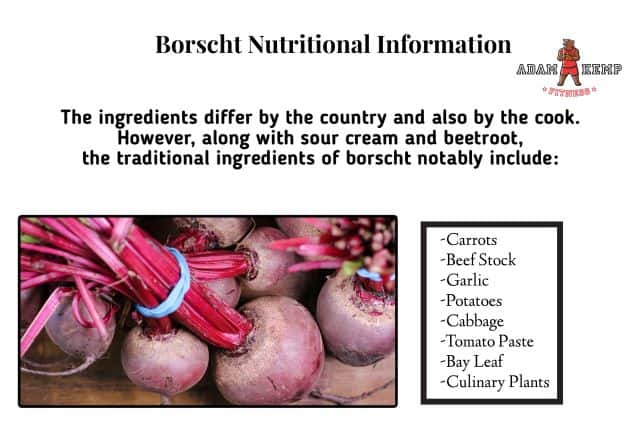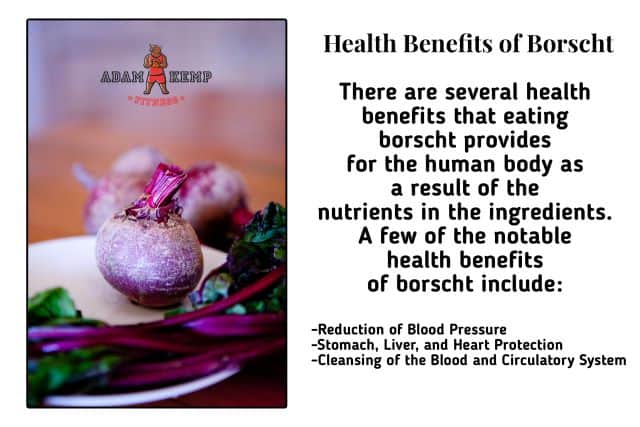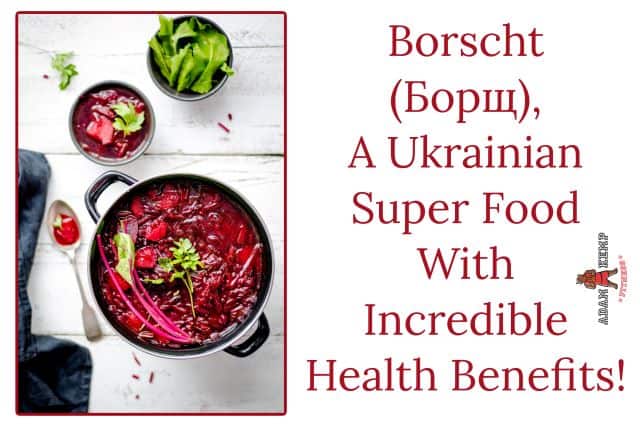Borscht Health Benefits: Is Borscht Healthy & Good for You?
Borscht is a beloved staple of Eastern European cuisine, with its roots tracing back to Ukraine. I first encountered this vibrant, hearty soup in 2015 while living in Kazakhstan, where my (now) wife introduced me to its rich flavors and health benefits.
There’s no one way to make borscht—recipes can range from simple to elaborate, with some boasting up to 30 ingredients so dense they claim your spoon will stand upright in the bowl! I’m still on the hunt for that legendary version.
I’ve had the privilege of tasting different variations of borscht while traveling through Poland, Russia, and Kazakhstan, as well as enjoying my wife’s version.
Each version was unique yet shared the comforting essence of a traditional borscht—but of course, my wife’s is still the best!
Typically, borscht takes 3 to 6 hours to cook, with beetroot as its star ingredient, giving it its signature deep red color. Though traditionally served hot, it can also be enjoyed cold, making it a versatile dish for any season.
The real magic of borscht lies in the nutritional power of beets, which are packed with essential vitamins and minerals that contribute to its status as a superfood. Read on to discover how this humble soup can support your health and well-being!
Common Ingredients in Borscht

The ingredients in borscht differ by country and also by the cook. However, along with sour cream and beetroot, the traditional ingredients of borscht notably include:
- Carrots
- Beef Stock
- Garlic
- Potatoes
- Cabbage
- Tomato Paste
- Bay Leaf
- Culinary Plants
The vegetables used in preparing borscht are rich in Vitamin C, antioxidants, and Vitamin B. The ingredients the cook decides to use in its preparation can substantially differentiate the flavor of borscht.
My wife makes an excellent pot of borscht, but you can find dramatically different tasting borscht which is delicious as well!
Potential Health Benefits of Borscht

Borscht offers several health benefits due to the nutrient-rich ingredients, particularly beets. Some of the key health benefits include:
Blood Pressure Reduction
Borscht can be a natural way to help lower blood pressure, thanks to the beets’ high nitrate content. Dietary nitrate improves blood flow by relaxing blood vessels, which can significantly reduce blood pressure.
A 2013 study published in the American Heart Association Journal found that individuals who consumed 8 ounces of beetroot juice experienced a drop in blood pressure by 10 mm Hg within about three hours.
While more research is needed, regularly consuming borscht may offer similar benefits for managing hypertension.
Stomach, Liver, and Heart Protection
Beets are rich in betaine, a compound that protects the liver, heart, and stomach. A 2007 study from Semmelweis University in Budapest showed that betaine helps safeguard the liver by reducing harmful homocysteine levels, which are linked to heart disease and stroke.
Additionally, betaine may increase stomach acid production in people with low levels, supporting better digestion and nutrient absorption.
Supports Healthy Blood Production
Beets, the star ingredient in borscht, are known for their blood-cleansing properties. They support red blood cell production, making them an effective remedy for anemia. In fact, beetroot has been used in treatments for leukemia and other cancers due to its powerful blood-purifying effects.
Including borscht in your diet can help harness these blood-cleansing benefits.
Incorporating borscht into your regular meals can provide numerous health benefits, from improving circulation to protecting vital organs.
Types of Borscht (Based on Country or Region)
The health benefits that you derive from eating borscht greatly depend on the type of recipe you use.
For instance, when making Polish white borscht, the ingredients used include sour cream, eggs, and bacon broth which will be far less healthy when compared with borscht which was prepared with vegetables and beets.
By simply skipping the sour cream, you will create healthier borscht!
You should pay attention to the recipe of borscht that you want to prepare or eat because the recipe greatly determines the ingredients used in its preparation. If you are vegan or vegetarian, you can avoid the ingredients which don’t fit your diet, and make vegan or vegetarian borscht!
It is much healthier to choose a borscht recipe that involves more vegetables, but sometimes adding more of those other ingredients adds just the right taste-touch!
Follow these guidelines to make your own and welcome in the benefits of this Ukrainian, power-house food!
How to Cook Borscht
Borscht is traditionally made in a large pot, simmering slowly to allow the flavors to meld together, but no two borscht recipes are exactly the same. The beauty of this dish lies in its adaptability—each region, family, and even individual brings their own spin to it.
From the vegetables used to the choice between beef, pork, or a completely vegetarian version, borscht can be tailored to suit a wide range of tastes and dietary preferences.
Many people pass down their borscht recipes from generation to generation, making slight modifications along the way, like adding or omitting ingredients based on what’s in season or on hand. In Ukraine, the birthplace of borscht, recipes often include beets, cabbage, potatoes, and carrots, while in Russia, you may find the addition of meat or beans.
My personal experiences have shown me just how diverse borscht can be, with each pot reflecting the cook’s history and culture. Some cooks even prepare a version with up to 30 ingredients, creating a thick, hearty meal that can keep you full for hours.
As time goes on, people often tweak their recipes to fit their personal preferences, experimenting with ingredients like mushrooms, different types of meat, or varying levels of sourness.
The soup’s signature flavor often comes from a balance of sweetness (from the beets) and acidity, traditionally achieved by adding ingredients like vinegar, lemon juice, or fermented rye bread.
However you decide to make it, cooking borscht is an opportunity to bring together the flavors of the past with your own modern touch, creating a dish that’s as comforting as it is delicious.
A Simple Borscht Recipe
Ingredients:
- 2 medium beets, peeled and grated
- 2 large carrots, peeled and chopped
- 1 large onion, diced
- 3 medium potatoes, peeled and cubed
- 1 small cabbage, shredded
- 4 cups vegetable or beef broth
- 2 tablespoons tomato paste
- 2 cloves garlic, minced
- 1 tablespoon olive oil
- 1 bay leaf
- Salt and pepper to taste
- Fresh dill for garnish
- Sour cream (optional, for serving)
Instructions:
- Prepare the vegetables: Peel and grate the beets, chop the carrots, dice the onion, and cube the potatoes. Shred the cabbage.
- Sauté the vegetables: In a large pot, heat olive oil over medium heat. Add the diced onion and garlic, sautéing until soft and translucent (about 5 minutes).
- Add beets and carrots: Stir in the grated beets and chopped carrots, cooking for another 5 minutes.
- Add the broth and potatoes: Pour in the broth, then add the cubed potatoes, tomato paste, bay leaf, salt, and pepper. Bring the mixture to a boil.
- Simmer the borscht: Lower the heat and let the borscht simmer for about 20 minutes, or until the potatoes are tender.
- Add cabbage: Stir in the shredded cabbage and cook for an additional 10-15 minutes, or until the cabbage is soft.
- Season and serve: Taste the borscht and adjust seasoning with salt and pepper if needed. Remove the bay leaf, and serve hot with a dollop of sour cream and fresh dill for garnish.
Final Thoughts: Is Borscht Good for You?
Borscht isn’t just a hearty, comforting soup; it’s a nutritional gem packed with health benefits. Originating from Ukraine, this vibrant dish has become a staple in Eastern European kitchens—and I personally discovered its magic while living in Kazakhstan in 2015, when my wife introduced me to this flavorful powerhouse.
Since then, it’s been a favorite in our household, not just for its taste but for the incredible health perks it offers.
At the heart of borscht’s health benefits is its star ingredient: beetroot. Beets are loaded with vitamins, minerals, and dietary nitrates that help improve blood circulation and lower blood pressure naturally.
In fact, a study published in the American Heart Association Journal found that people who drank beet juice saw their blood pressure drop by an impressive 10 mm Hg within hours. If beet juice can do that, imagine what a rich, flavorful bowl of borscht can do when eaten regularly!
Beyond heart health, borscht’s nutrient-rich ingredients work wonders for your liver, stomach, and even your blood. The beets in borscht are packed with betaine, a compound that protects your liver from toxins, supports digestion by increasing stomach acid production, and reduces harmful homocysteine levels linked to heart disease and stroke.
Plus, the cleansing power of beets can help boost red blood cell production, making this soup a fantastic remedy for anemia or overall blood health.
And the best part? Borscht is incredibly versatile. Whether you prefer a vegetarian version brimming with veggies or a more traditional recipe with meat and sour cream, you can easily adapt it to suit your taste and dietary needs.
No matter how you make it, borscht is a delicious way to nurture your body and boost your overall well-being.
So, the next time you’re looking for a meal that satisfies your taste buds and fuels your body with nutrients, borscht should definitely be on your list.



